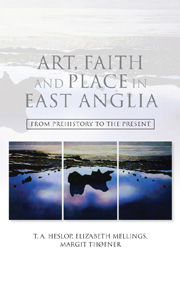Book contents
- Frontmatter
- Contents
- Acknowledgements
- List of illustrations
- CHAPTER 1 ‘Introduction: On Faith, Objects and Locality’
- CHAPTER 2 ‘But where is Norfolk?’
- CHAPTER 3 ‘Sacred Image and Regional Identity in Late-Prehistoric Norfolk’
- CHAPTER 4 ‘Piety from the Ploughsoil: Religion in Roman Norfolk through Recent Metal-Detector Finds’
- CHAPTER 5 ‘Paganism in Early-Anglo-Saxon East Anglia’
- CHAPTER 6 ‘Devotion, Pestilence and Conflict: The Medieval Wall Paintings of St Mary the Virgin, Lakenheath’
- CHAPTER 7 ‘Here Be Dragons: The Cult of St Margaret of Antioch and Strategies for Survival’
- CHAPTER 8 ‘The Medieval Jews of Norwich and their Legacy’
- CHAPTER 9 ‘Late-Medieval Glass-Painting in Norfolk: Developments in Iconography and Craft c.1250–1540’
- CHAPTER 10 ‘Graffiti and Devotion in Three Maritime Churches’
- CHAPTER 11 ‘Norfolk Wayside Crosses: Biographies of Landscape and Place’
- CHAPTER 12 ‘Landscapes of Faith and Politics in Early-Modern Norwich’
- CHAPTER 13 ‘Practice and Belief: Manifestations of Witchcraft, Magic and Paganism in East Anglia from the Seventeenth Century to the Present Day’
- CHAPTER 14 ‘Provinciality and the Victorians: Church Design in Nineteenth-Century East Anglia’
- CHAPTER 15 ‘Maharajah Duleep Singh, Elveden and Sikh Pilgrimage’
- CHAPTER 16 ‘Supernatural Folklore and the Popular Imagination: Re-reading Object and Locality in Mid-Nineteenth-Century Norfolk’
- CHAPTER 17 ‘Pro Patria Mori: Christian Rallies and War Memorials of Early-Twentieth-Century Norfolk’
- CHAPTER 18 ‘Pagans in Place, from Stonehenge to Seahenge: “Sacred” Archaeological Monuments and Artefacts in Britain’
- CHAPTER 19 ‘Art, Spirit and Ancient Places in Norfolk’
- CHAPTER 20 ‘Sacred Sites and Blessed Objects: Art and Religion in Contemporary Norfolk’
- Bibliography
- Index
CHAPTER 9 - ‘Late-Medieval Glass-Painting in Norfolk: Developments in Iconography and Craft c.1250–1540’
Published online by Cambridge University Press: 05 April 2013
- Frontmatter
- Contents
- Acknowledgements
- List of illustrations
- CHAPTER 1 ‘Introduction: On Faith, Objects and Locality’
- CHAPTER 2 ‘But where is Norfolk?’
- CHAPTER 3 ‘Sacred Image and Regional Identity in Late-Prehistoric Norfolk’
- CHAPTER 4 ‘Piety from the Ploughsoil: Religion in Roman Norfolk through Recent Metal-Detector Finds’
- CHAPTER 5 ‘Paganism in Early-Anglo-Saxon East Anglia’
- CHAPTER 6 ‘Devotion, Pestilence and Conflict: The Medieval Wall Paintings of St Mary the Virgin, Lakenheath’
- CHAPTER 7 ‘Here Be Dragons: The Cult of St Margaret of Antioch and Strategies for Survival’
- CHAPTER 8 ‘The Medieval Jews of Norwich and their Legacy’
- CHAPTER 9 ‘Late-Medieval Glass-Painting in Norfolk: Developments in Iconography and Craft c.1250–1540’
- CHAPTER 10 ‘Graffiti and Devotion in Three Maritime Churches’
- CHAPTER 11 ‘Norfolk Wayside Crosses: Biographies of Landscape and Place’
- CHAPTER 12 ‘Landscapes of Faith and Politics in Early-Modern Norwich’
- CHAPTER 13 ‘Practice and Belief: Manifestations of Witchcraft, Magic and Paganism in East Anglia from the Seventeenth Century to the Present Day’
- CHAPTER 14 ‘Provinciality and the Victorians: Church Design in Nineteenth-Century East Anglia’
- CHAPTER 15 ‘Maharajah Duleep Singh, Elveden and Sikh Pilgrimage’
- CHAPTER 16 ‘Supernatural Folklore and the Popular Imagination: Re-reading Object and Locality in Mid-Nineteenth-Century Norfolk’
- CHAPTER 17 ‘Pro Patria Mori: Christian Rallies and War Memorials of Early-Twentieth-Century Norfolk’
- CHAPTER 18 ‘Pagans in Place, from Stonehenge to Seahenge: “Sacred” Archaeological Monuments and Artefacts in Britain’
- CHAPTER 19 ‘Art, Spirit and Ancient Places in Norfolk’
- CHAPTER 20 ‘Sacred Sites and Blessed Objects: Art and Religion in Contemporary Norfolk’
- Bibliography
- Index
Summary
INTRODUCTION
The late-medieval churches of Norfolk have a distinctive character. This relates closely to the environment in which they were built and the people who commissioned and fashioned them. Up until the late thirteenth century, it was rare to find many window openings and they were generally of small size. In part, this was because of the lack of local building stone to supplement the flint rubble, from which the plain walls were constructed. As a result, the framing of windows and any tracery within them had to be made from expensive imported material. Structurally, too, there was a consequence: walls were thick and low, which again meant areas of glass were minimal. However, from around 1300 until the Reformation, growing technical expertise and confidence allowed a very substantial increase in wall height and window size and these were exploited for two purposes. One was to raise light levels in the church and the other was to provide space that could be filled with religious imagery in stained glass. Although these conditions pertained elsewhere in parts of England, there was nowhere outside East Anglia where churches so consistently had their aisle windows dramatically enlarged and clerestories added above the nave arcading, and where the shafts supporting the arcade were designed and placed to maximise the visibility of the glass. Two factors were crucial: a wealthy and pious population willing to pay for the work and the expertise to devise and manufacture appropriate imagery.
- Type
- Chapter
- Information
- Art, Faith and Place in East AngliaFrom Prehistory to the Present, pp. 130 - 147Publisher: Boydell & BrewerPrint publication year: 2012



